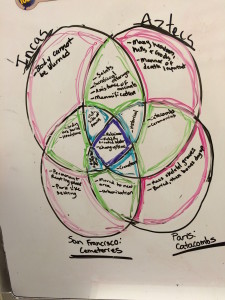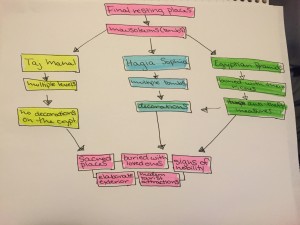I ended up making a Venn diagram on the treatment of the dead and looked at the Inca’s, Aztec’s, Paris catacombs and the San Francisco cemeteries. I ended up comparing and contrasting them all individually and then between one another. The main theme of my topic is that treatment of the dead is a religious practice that varies only slightly between time and place. Like everything else the more time that passes the more things evolve and change. With this passage of time, we tend to place less emphasis on the past or the dead and think more about the future or living.
As you can see from my diagram each topic has its own individual characteristics from the others but they all have similarities in the way they treated the dead right after death and as time passed. The Incas and Aztecs civilization are both further back in history where preservation of the dead, offerings and polytheism were prevalent. Religion played a much bigger role in the world and heritage and history was needed to show station. As time has passed religion isn’t as big of a driving force in how the world works, mostly there is only one god and we now believe in technology, innovation and progress. This is what shows in the Paris catacombs and San Francisco cemeteries, these events happened in a giant boom for the economy and expansion fueled our drive for a, ‘bigger and more” mentality. The world was growing at such a fast pace and it was no longer necessary to know your heritage, as your birth no longer dictated your station in life. With all of this, the treatment of the dead had to be moved out of the way into a place that would be less disturbing to progress but still enable the dead to be remembered.

